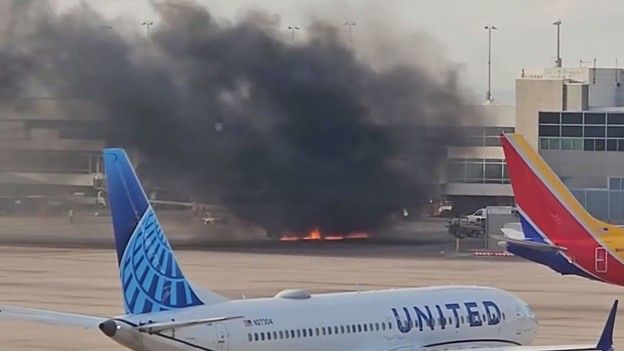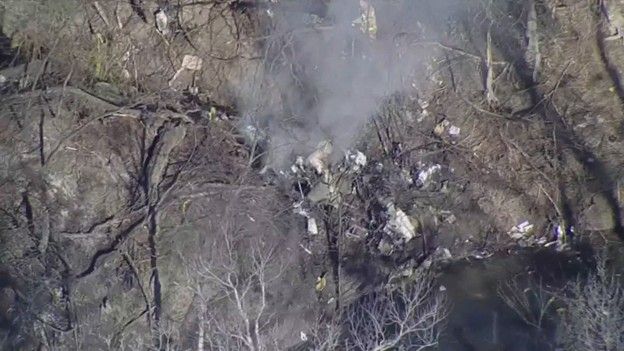ARFF Daily News
Published on:
Friday the 14th of March, 2025
Passengers evacuate onto wing of American Airlines plane after engine catches fire at Denver airport
By Pete Muntean, Alexandra Skores, Amanda Musa, Amanda Jackson and Lex Harvey, CNN
Dozens of passengers were forced to stand on the wing of an American Airlines plane at Denver International Airport as they evacuated the aircraft after one of its engines caught fire Thursday evening, sending thick black smoke billowing into the air.
This is the latest incident in a spate of alarming aviation disasters and close calls which have stoked worries among flyers.
American Airlines Flight 1006, a Boeing 737-800 en route to Dallas-Fort Worth from Colorado Springs with 172 passengers and six crew aboard, diverted to Denver around 5:15 p.m. local time, after the crew reported “engine vibrations,” the Federal Aviation Administration said in a statement.
“After landing and while taxiing to the gate an engine caught fire,” the statement said. The FAA is investigating.
Shortly before landing, the plane’s pilot notified air traffic controllers in Denver that the flight was experiencing engine issues, but it was not an emergency, according to air traffic control audio from LiveATC.net.
“American 10,006, uh, 1006 just to verify not an emergency still, correct?” the controller asked.
“Nah, we just have a high engine vibration so we are cruising slower than normal,” the pilot responded.
The situation appeared to quickly escalate several minutes later, after the plane landed, when someone on the radio yelled “Mayday, Mayday, Mayday! Mayday! … engine fire!”
The plane arrived at gate C38, a Denver International Airport spokesperson told CNN. The fire was extinguished and all passengers were evacuated, the spokesperson said.
Images from the scene show dozens of passengers exiting the aircraft and standing on the wing as smoke filled the air. Some passengers evacuated the plane on a slide, according to video published by Reuters.
Twelve passengers were taken to the hospital with minor injuries, Denver Fire Department told CNN.
“We thank our crew members, DEN team and first responders for their quick and decisive action with the safety of everyone on board and on the ground as the priority,” American Airlines said in a statement.
Video captured by a Montana woman inside the airport waiting for a connecting flight shows a large cloud of smoke emanating from the plane and dozens of passengers running away.
Kristal Leonard, who was flying in from Helena, Montana, told CNN she was waiting inside the Denver International Airport for her connecting flight to Colorado Springs. That is when she looked outside and saw flames and smoke engulfing the plane.
“I was terrified for those passengers,” Leonard said. “I can’t even imagine how scared they must’ve been.”
Ground crews appeared to extinguish the fire relatively quickly, according to a video filmed by a passenger inside the airport. Footage shows bright orange flames and black smoke disappearing and turning into a misty white haze as workers put out the fire.
American Airlines is sending a replacement aircraft and crew to Denver to help customers continue on to Dallas, the airline said.
Thursday’s plane engine fire comes just three weeks after a Delta Air Lines flight crashed, turned upside down and caught fire on the runway at Toronto Pearson International Airport.
That incident was preceded by deadly crashes this year in Alaska, Philadelphia, and Washington, DC, where an American Airlines plane collided midair with a US Army Black Hawk helicopter in January, killing 67 people.
In December, aviation disasters in South Korea and Kazakhstan killed more than 200 people.
https://www.cnn.com/2025/03/13/us/american-airlines-fire-denver-airport/index.html


'Could have been a lot worse:' One dead after small plane crashes in North Texas, officials say
A small plane crashed in a wooded area in Mesquite, officials said.
Author: Rachel Behrndt, Richard Solomon
MESQUITE, Texas — One person died after a small plane crashed into a wooded area in Mesquite, east of Dallas, on Thursday, officials said.
A Cessna CitationJet crashed after taking off from the Mesquite Metro Airport around 7:40 a.m. Thursday morning near East Cartwright Road and Lawson Road, officials said. The site of the crash is just blocks away from the airport.
One person, the pilot, died in the crash, Mesquite police said in a press release.
It's unclear whether the plane was departing or arriving from the Mesquite Metro Airport, Travis Block, a spokesperson for the Mesquite Fire Department said. The pilot managed to avoid all of the houses and buildings in the area before crashing in a wooded area, Block said.
"We're just thankful they didn't hit any structures," Block said. "It could have been a lot worse."
First responders remained on the scene extinguishing small fires Thursday morning, Block said. However, the fire is contained and not spreading, he added.
The pilot was the only person onboard the plane at the time of the crash, the Federal Aviation Administration said in a statement. The FAA and NTSB will investigate the crash.
There was no damage to residences and other buildings in the area around the crash, Mesquite police said in a press release.
Ron McCallum, a fellow pilot and aviation attorney, was a close friend of the victim.
He told WFAA that the pilot, had more than 20 years of experience as an aviator and was conducting a maintenance flight when the aircraft went down.
"The captain was a dedicated father, a loyal husband, a loyal friend," McCallum said.
McCallum said that, based on information he received from air traffic control, the aircraft never climbed above 1,000 feet, an altitude he described as critical for a jet of this type. However, investigators have yet to determine the cause of the crash.
Despite the devastating crash, Mesquite fire officials confirmed that no homes or buildings were damaged, and no one else was injured.
McCallum says his friend’s legacy will be one of selflessness and care for others.
"I don't have words for that, other than he's thinking about others before himself," he said.
https://www.khou.com/article/news/local/texas/mesquite-texas-plane-crash-updates-faa-police/287-71d70645-44a1-47b2-9514-b78bf062429f

NTSB Final Report: Benjamin Pratt Bearhawk Patrol
Later In The Flight, He Encountered Carburetor Icing That Wasn’t Clearing With The Application Of Carburetor Heat
Location: Galena, Alaska Accident Number: ANC24LA014
Date & Time: February 18, 2024, 16:00 Local Registration: N406AK
Aircraft: Benjamin Pratt Bearhawk Patrol Aircraft Damage: Substantial
Defining Event: Fuel related Injuries: 1 None
Flight Conducted Under: Part 91: General aviation - Personal
Analysis: The pilot reported that while enroute, flying below a 1000-foot ceiling in 2 miles of visibility and light snow, he encountered various instances of carburetor icing which were resolved using the periodic application of carburetor heat. However, later in the flight, he encountered carburetor icing that wasn’t clearing with the application of carburetor heat. The pilot elected to make an off-airport landing and while performing a descending 180° turn, maneuvering to land, he reported that the airplane’s engine lost all power. The pilot leveled the airplane’s wings partway through the turn and landed straight ahead, in a small clearing. The airplane overran the landing area and impacted a clump of trees which resulted in substantial damage to the wings.
According to the Carburetor Icing Probability Chart (FAA SAIB CE-09-35), the atmospheric conditions at the time of the accident were conducive to carburetor icing at cruise power and glide power.
According to FAA Advisory Circular 20-113, "To prevent accidents due to induction system icing, the pilot should regularly use [carburetor] heat under conditions known to be conducive to atmospheric icing and be alert at all times for indications of icing in the fuel system."
The pilot reported that there were no preaccident mechanical failures or malfunctions with the airplane that would have precluded normal operation.
Probable Cause and Findings: The National Transportation Safety Board determines the probable cause(s) of this accident to be -- A loss of engine power as a result of carburetor ice. Contributing to the outcome was the pilot’s failure to effectively use carburetor heat in conditions conducive to the formation of carburetor ice.
FMI: www.ntsb.gov

Today in History
53 Years ago today: On 14 March 1972 Sterling Airways flight 296, a Caravelle, impacted a mountain during descent towards Dubai Airport, UAE, killing all 112 occupants.
Date: Tuesday 14 March 1972
Time: 22:04
Type: Sud Aviation SE-210 Caravelle 10B3
Owner/operator: Sterling Airways
Registration: OY-STL
MSN: 267
Year of manufacture: 1970
Total airframe hrs: 6674 hours
Engine model: P&W JT8D-9
Fatalities: Fatalities: 112 / Occupants: 112
Other fatalities: 0
Aircraft damage: Destroyed, written off
Category: Accident
Location: ca 20 km W of Kalba - United Arab Emirates
Phase: En route
Nature: Passenger - Non-Scheduled/charter/Air Taxi
Departure airport: Bombay-Santacruz Airport (BOM/VABB)
Destination airport: Dubai Airport (DXB/OMDB)
Investigating agency: DAI
Confidence Rating: Accident investigation report completed and information captured
Narrative:
Sterling Airways flight 296, a Caravelle, impacted a mountain during descent towards Dubai Airport, UAE, killing all 112 occupants.
Flight NB296 was a charter service from Colombo (CMB), Sri Lanka to Copenhagen (CPH), Denmark. Refueling stops were planned at Bombay, Dubai, and Ankara.
After a one-hour stopover at Bombay, the flight took off for Dubai at 15:20 hours UTC. An IFR flight plan was submitted for airway R19, containing five reporting points. The en route altitude was FL310 and all reporting points were passed ahead of schedule.
At 17:25 the crew received the current Dubai weather information which showed a wind from 040 degrees at 8 knots; 10 km visibility; and 5/8 clouds at 2000 feet.
At 17:42 the flight contacted Dubai Approach and reported on the 084 radial of the Dubai (DO) VOR. The approach controller told the crew to expect descent clearance at 17:55. However, at 17:49, the crew radioed approach control, requesting an immediate descent as they were 95 NM out. Unknown to the crew, their actual position was 162 NM from Dubai.
The controller cleared the flight down to 4000 feet and reported that runway 30 and 12 were both available. The flight replied: "We will see if we can make this a straight in on 30".
At 17:56 hours the flight reported descending through FL135. The controller replied: "Recleared 'DO' 2000 feet on Dubai 1016 mb report 2000 feet or field in sight". In conditions of darkness the flight crew likely spotted the city lights of Fujayrah, Ghurayfah and Kalba during the descent, assuming these were the lights of Dubai.
Radio contact between the flight and Dubai Approach became more difficult during the descent over mountainous terrain. As a result of flying over mountainous terrain, about 80 km to the east of Dubai, flight 296 also had difficulty in tuning into the NDB and VOR frequencies.
Descent was continued until the plane struck a mountain ridge at 1600 feet.
The reason for the accident was that the aircraft was flown below the prescribed minimum altitude, probably because:
1. The pilots thought that they were closer to their destination than they actually were, supposedly due to the incorrect information on the outdated flight plan in use or due to a misreading of the weather radar, or a combination of both.
2. The pilots thought they had their position confirmed when they got visual contact with the towns of Fujayrah, Ghurayfah and Kalba, mistaking these for Dubai.

